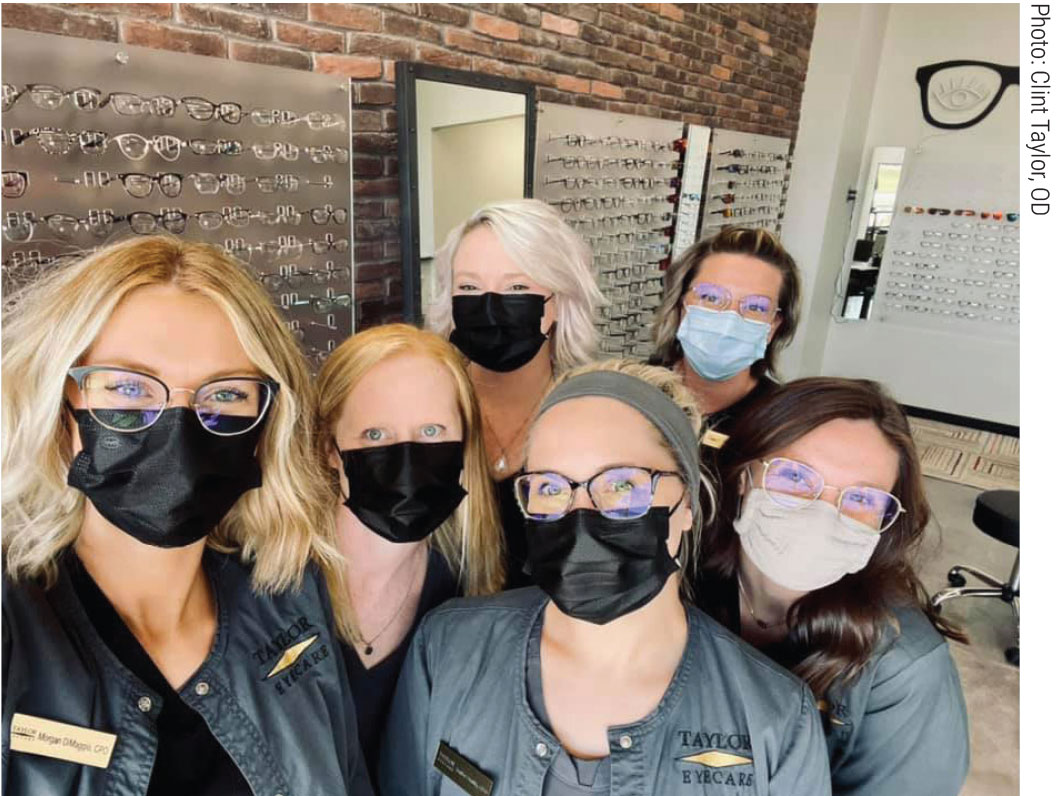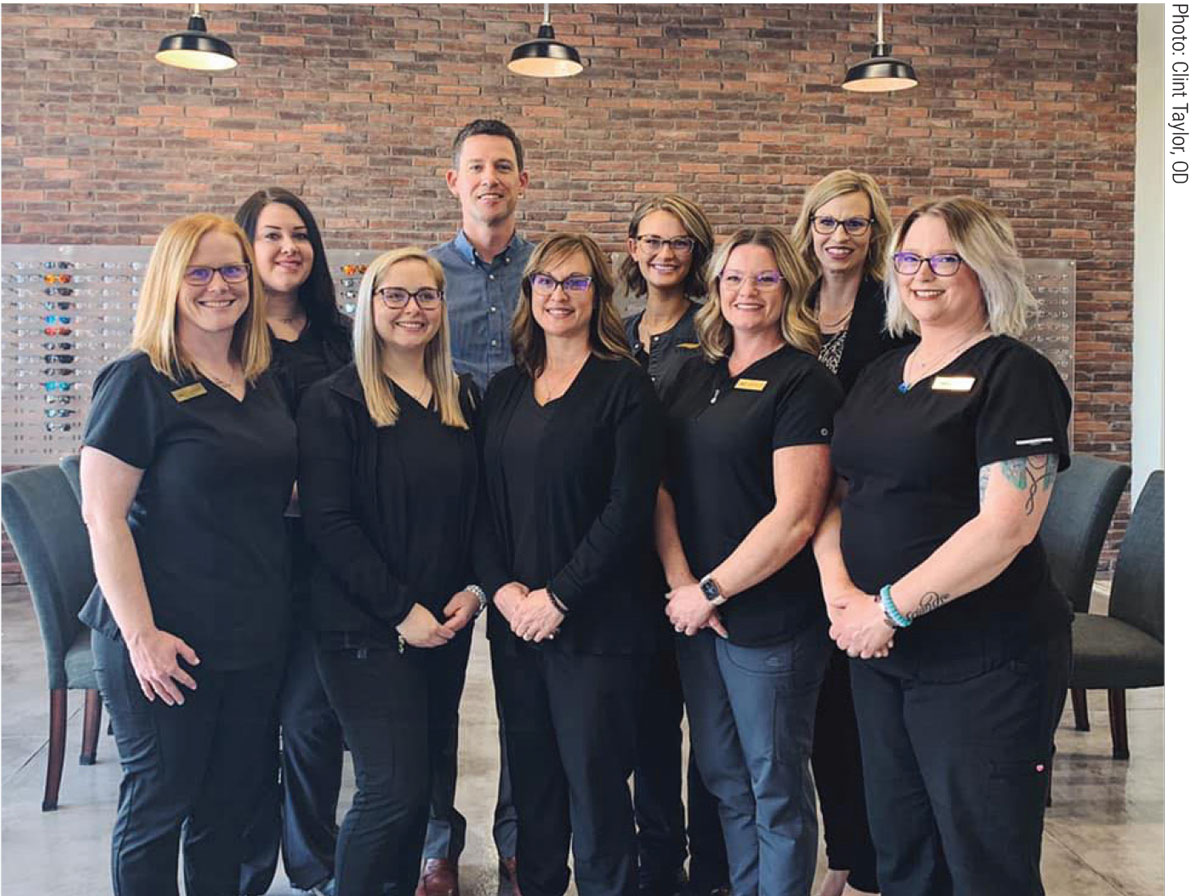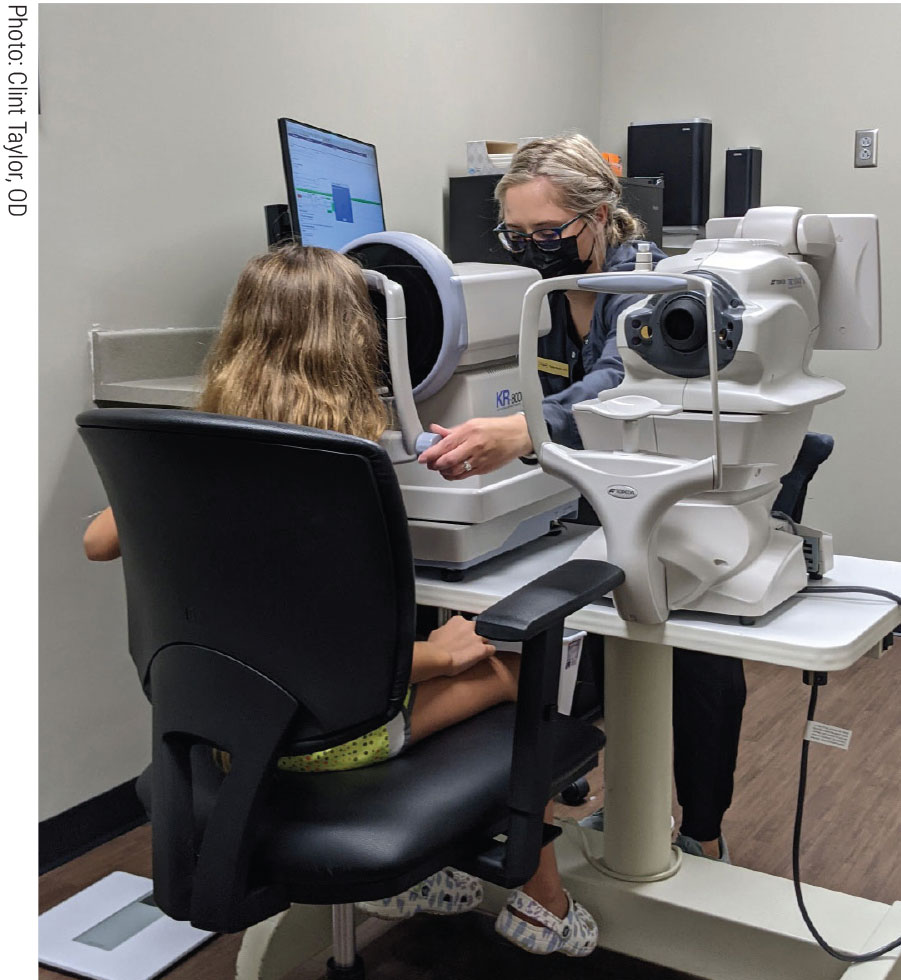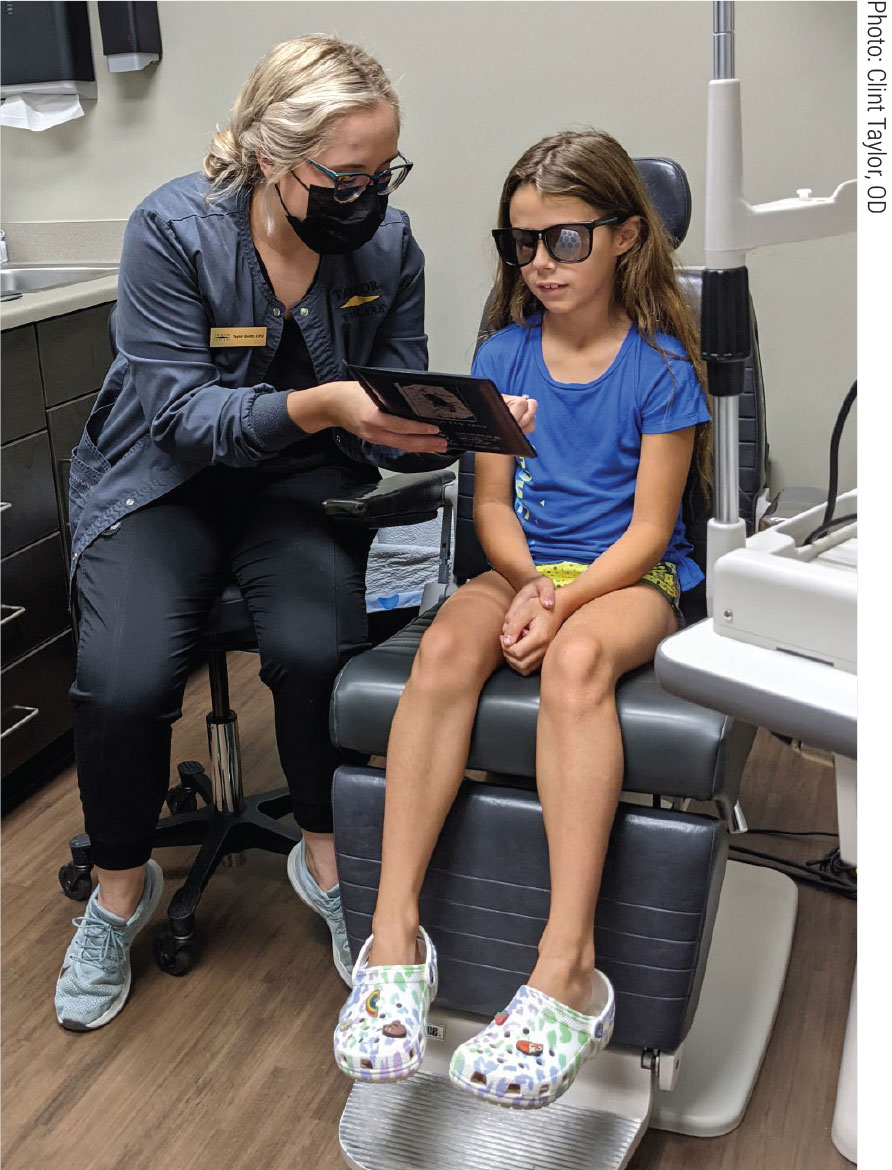Hiring used to be a straightforward process: an employer would take out an ad or ask for a referral from a trusted source, sift through a stack of applications, conduct several interviews and then make an offer to the best candidate. However, due to the current labor shortage—coupled with the trend of employers having to bump up employee pay since COVID—hiring has gone from business as usual to a headache for many companies, including optometric practices.
For Dori Carlson, OD, of Heartland Eye Care in Grafton, ND, her biggest challenge in hiring and retaining staff has been the current lack of a workforce.
 |
| It’s important to ensure each of your staff members are happy in their role, and step in if they’re not. |
“We finally are fully staffed after over three years of struggling to find the right people,” says the former AOA president. “We would advertise and have two applicants who weren’t qualified. So, we’d pull the advertising and try again later. This summer, we finally had qualified applicants.”
In New Hampshire, hiring and retaining good staff is equally as challenging, says Scott Huffer, OD, a partner at Drs. Helfman, Lasky & Associates in Nashua.
“There are a lot of job openings, and our staff members are being offered jobs everywhere they go,” Dr. Huffer says. “We particularly have difficulty with opticians, as there are very few well-trained opticians in our area.”
Just like a buyers’ or sellers’ market in real estate, today’s hiring landscape is an employees’ market, says optometrist and CEO of the Power Practice, Bethany Fishbein.
In its August jobs report, the National Federation of Independent Businesses found that 50% of owners had job openings they couldn’t fill, a record high for the second consecutive month.1 Additionally, the number of unfilled job openings remains far above the 45-year historical average of 22%.1
Despite the daunting statistics, ODs are finding ways to remain competitive.
“It’s important to take good care of your staff, be a great place to work and put effort into creating a positive office culture and environment where people want to be and will enjoy the time they spend at your practice. Now more than ever, an employee’s life outside of the office is extra stressful,” says Dr. Fishbein, who co-owns two practices in Somerset, NJ.
Market Your Practice
In today’s ultra-competitive hiring market, it’s critical that businesses spell out an answer to the implicit question, “Why us?” in their help-wanted ads, as opposed to previous years when it was the interviewee’s job to convince you, “Why them?” says Dr. Fishbein.
When advertising for a position, Dr. Fishbein suggests including information on what makes your practice stand out, including your work culture, employee benefits and extra perks such as weekends or school vacations off.
“Whatever is unique about working for you, include that in the initial ad to attract applicants to you over the other options they have,” Dr. Fishbein says.
For example, Dr. Fishbein recently made her office even more staff-friendly by cutting hours. Prior to COVID, her office was open every other Sunday. Following the pandemic’s onset, a few of her staff members didn’t return because they had young children and needed to be home. Due to the sudden staffing shortage, her practice eliminated night and weekend hours, a popular trend Dr. Fishbein is hearing from her clients as well. Other practices are experimenting with four-day work weeks, with longer hours but the promise of three-day weekends, she says.
To remain competitive, Dr. Huffer is considering changing his practice’s benefit structure, since he says employees seem focused on their hourly wage and not their total compensation.
“We pay 75% of health insurance premiums, in addition to offering profit sharing and generous time off policies, but employees seem focused on their salary,” Dr. Huffer explains. “I think we may be better served to move to paying a higher wage while maintaining the total compensation. I think employees notice that much more.”
Additionally, a practice owner should keep hiring on the forefront of their mind, he says. This includes networking at local association meetings and asking colleagues how happy they are at their jobs. This is particularly important because adding a doctor to a practice can take time, he says.
Another potential resource for identifying new hires: existing employees.
 |
| Dr. Taylor has little turnover in his practice, which he attributes to the family atmosphere he says is part of the office culture. Click image to enlarge. |
“We’ve found that our current staff members are our best resource for finding new employees,” says Clint Taylor, OD, owner of Taylor Eye Center in Carmi, IL. “The nine members of our team have a wide network of friends, family and acquaintances, and they have served as a pipeline of sorts for potential new employees.”
Regardless, no matter how thorough of an interview and background check you conduct, there’s still a question of how well a given candidate will perform and fit in, Dr. Taylor adds.
“I’ve had candidates knock their interview out of the park and receive glowing recommendations from references, and then underperform after they were hired. And the opposite has been true—candidates we’ve had doubts about during the interview process have turned out to be real all-stars once they were given a chance and hired. Only after a few months of having the new employee in the office regularly do you start to get a feel for their true potential,” Dr. Taylor says.
Dr. Carlson has added personality testing to her hiring process. “It gives us a little more information about the person that may not reflect in an interview,” she says.
For Ken Krivacic, OD, MBA, of Irving, TX, his philosophy has always been to hire for personality and not as much for skill, as he believes employees can be trained.
“A person with a positive attitude who likes showing up for work outweighs potentially not having the skill level you’re looking for,” says Dr. Krivacic, who spent three decades as the sole owner of a private practice and continues to see patients through his new partnership with MyEyeDr. “I felt that hiring approach served us well for over 30 years.”
Beyond the usual hiring tools, Dr. Taylor created his own test to assess prospective employees’ talents and personalities.
“After their interview, I ask myself this question, ‘If I was going to be on a three-hour flight, would I choose to sit next to this person or not?’ I’ve found that the answer to that question tells me a lot about whether or not they’ll fit in with our culture,” he says.
Staff Retention Tips
One in four workers may be seeking out opportunities with a new employer once the pandemic threat has subsided, indicating talent migration could be imminent as employees look for increased flexibility and opportunities to grow their careers, according to Prudential Financials Pulse on the American Workers Survey.2
One strategy to promote employee retention is to offer staff bonus incentives both on a monthly and annual basis, Dr. Krivacic says. Bonuses should be simple and easy for employees to understand, reasonable to obtain and motivational, he suggests.
“Only offering a yearly incentive may not be as effective as a monthly bonus, as staff can get distracted,” he adds. Monthly bonuses can also be discussed during weekly meetings, which can provide a forum for employees to know where they stand.
Another tip in employee retention: learn to trust those who work for you, he adds.
 |
| Make sure to allocate staff vs. doctor responsibilities to create a better office workflow. |
“If you let your staff take charge at times and make some decisions, it can help them grow as employees and value their job more,” Dr. Krivacic says. “Sometimes, staff have made decisions I wouldn’t have made, and in those cases, we’d talk afterward. But I didn’t want them to be scared to make a decision. It’s not a big deal; the practice isn’t going to close if a wrong decision is made. I think any successful business has learned to trust its employees. If the employee is empowered to make decisions, it’s often better for the patients too.”
Dr. Huffer had a few employees who were considering leaving for another job that offered more money. In these cases, he sat down with the individuals and discussed what it would take to convince them to stay. In some instances, he was able to retain an employee by offering a raise or a change in job responsibilities, including a transition from full- to part-time.
In today’s working environment, everyone is short-staffed, and many employees are overworked, Dr. Huffer adds. It’s important to make sure staff are thanked and encouraged, and many employees benefit from positive feedback, he says.
“Occasionally, we will buy our staff lunch or provide an ice cream break. It’s critical to maintain good morale, or the problem can spiral. You need to be a good place to work,” he says. Dr. Huffer also makes an effort to recognize birthdays and employment anniversary dates.
Retention of good employees can mean more than salary adjustments, Dr. Carlson adds. Her practice has five employees who have been with her for at least 20 years. Ultimately, retention of employees comes down to culture, she feels.
Dr. Carlson says her practice is a fun place to work where staff are treated like family. Her practice also offers a generous benefits package, including 100% coverage of employees’ health insurance and schedule flexibility.
“People bring their lives with them to the office. They can’t leave them at the door, as much as we would like them to do just that,” Dr. Carlson explains. “We’ve learned that offering flexibility with regard to work hours is one of the benefits they appreciate the most. We all cover for each other.”
Should Staff Refract?Once hired, now the focus shifts to which tasks staff should handle, and which the doctor should take charge of. Every practice divvies up patient testing differently, with “who handles refraction” remaining a point of debate. Dr. Carlson passes the baton as much as possible to staff. Clinically, she believes employees are responsible for all pretesting, including history, acuities, entrance testing, autorefraction, dark adapt screening and Optomap imaging (Optos), in addition to contact lens training and education and all optical functions. On the business side, her staff takes on invoice processing, insurance billing, contact lens and optical orders, marketing and social media. “I believe refractions are part of the data gathering process, and for several years, we had staff do refractions,” Dr. Carlson says. Her practice uses Marco refraction systems, and staff received training directly from the company, she explains. However, doctors always have the final say in the prescription. Dr. Carlson’s practice stopped having techs refract a few years ago when a few long-term employees left. “At that time, it made more sense to install more digital refraction units in the exam rooms, rather than train people when our staffing was in a state of flux,” she says. Likewise, Dr. Taylor delegates many exam tasks to his staff. When the tech pages him to enter the exam room, all pretesting has been performed and entered into the chart and the patient’s habitual glasses prescription has been added to the phoropter. “I currently refract our patients, but would be open to having technicians refract, given the right training and equipment,” he says. There is no right or wrong answer to whether staff should do refractions, Dr. Krivacic believes. “It’s okay to delegate the task and have the OD do the final review,” he says. Still, Dr. Krivacic has received negative feedback regarding staff refracting them instead of the doctor. |
COVID’s Impact
Dr. Fishbein noted a trend of staff burnout, which has heightened during COVID; staying in tune with employees’ mental health is important, she says.
“People are dealing with a lot of issues right now. Employees may have health concerns or their children are starting school, and at any given moment, the school can shut down and your staff member may need to be home with their kids for two weeks. As an employer, you must be sensitive to what else is going on in your staff’s lives,” she says.
Flexibility, when it can be offered, is key in keeping staff happy.
 |
| Fully empowered and well-trained staff can devote more time with patients, particularly kids, freeing up the OD. |
If a staff member requires more flexibility, Dr. Fishbein suggests looking for opportunities where the employee can remain productive while working from home, a win-win scenario. This could include answering phones, checking insurance or working on a project.
“Right now, everybody on a team needs to be more understanding of each other,” Dr. Fishbein suggests.
COVID is also forcing practices to adapt in other areas, with virus exposure causing people to quarantine and vaccine mandates potentially posing another wrinkle in hiring and retaining staff.
“I am a little concerned about one or two employees that may leave rather than be vaccinated,” Dr. Huffer says.
Another ripple effect of COVID: increased salaries.
“With a tighter labor market, we’re hiring people away from another job. So, we’ve had to increase starting salaries to attract employees, which then means we’ve had to increase salaries across the board,” Dr. Carlson adds.
Dr. Huffer also had to increase pay for many employees. “In our area, there are help-wanted signs with high starting hourly wages posted seemingly everywhere,” he says.
You Get Out What You Put In
In the current labor market, staff training is as important as ever for both the employee and the practice. A recent article in the Harvard Business Review suggests when employers favor hiring over training, the labor market can’t keep up.3 Instead, many organizations compete for the top, job-ready talent rather than help incumbents or younger underserved and underrepresented groups develop the skills they need to fill tomorrow’s roles.3
At Dr. Carlson’s practice, she says weekly staff meetings have helped immensely in the training process. “We find it takes less time to train people when we have uninterrupted time to explain technical skills, culture and philosophy of care,” she adds. Dr. Carlson also takes advantage of online training modules.
Of course, training isn’t a one-size-fits-all approach.
“For training, it’s about finding what you need someone to learn and then accommodating how much more the individual wants to learn,” Dr. Fishbein says. “There are employees who really see continuous growth as an amazing perk and a reason they want to work at your office.” For this type of employee, you will want to create continuous learning opportunities, she notes.
On the other hand, there might be another employee in the same position with a different personality who may get stressed over the thought of additional training and prefer to do the job they were hired for and nothing more, Dr. Fishbein adds.
“This person isn’t a terrible employee, but you need to have conversations with staff to understand who wants to be pushed, and for those who don’t want that challenge, give them room to tell you when their situation changes. An employee may have other issues going on in their lives outside of work and not want to take on additional responsibilities at that moment,” Dr. Fishbein says.
Final Thoughts
Dr. Krivacic considers staff as an asset and not a cost. If you have a good staff member, they’re going to more than make up what you’re paying them and be a benefit to the practice, he says.
“Often, we don’t appreciate our employees like we should,” Dr. Krivacic says. “With the current labor market and the fact that it’s hard to find good people, I think we’re seeing employers valuing their staff more.”
1. August 2021 report: small business optimism increased slightly in August. NFIB. August 2021. www.nfib.com/surveys/small-business-economic-trends/. Accessed September 18, 2021. 2. Increasingly, workers expect pandemic workplace adaptations to stick. Prudential. April 6, 2021. news.prudential.com/increasingly-workers-expect-pandemic-workplace-adaptations-to-stick.htm. Accessed September 18, 2021. 3. Harris S, Schwartz J. Why competing for new talent is a mistake. Harvard Business Review. February 5, 2020. hbr.org/2020/02/why-competing-for-new-talent-is-a-mistake. Accessed September 19, 2021. |











